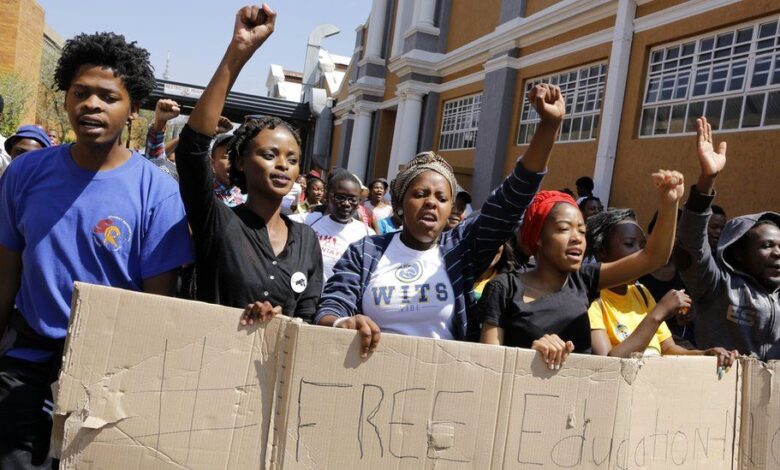Why Are Students Protesting at Universities?

Searching for answers to why students are protesting at universities? This article explores the various reasons behind student protests, examining the causes, implications, and responses to these demonstrations. Student protests are a significant aspect of university life, often reflecting broader social, economic, and political issues. Understanding the motivations behind these protests provides insights into the current landscape of higher education and student activism.
Understanding Student Protests
Student protests have been a part of university life for decades, driven by a range of issues. To comprehend why students are protesting at universities, it’s essential to look at the underlying factors and common themes in these movements.
Common Causes of Student Protests
Tuition Fees and Student Debt
One of the primary reasons students protest is the rising cost of tuition and student debt. Students often demand lower fees, better financial aid, and policies to reduce the financial burden on graduates.
Campus Policies and Administration
Protests frequently arise over campus policies or administrative decisions. These can include issues like the handling of sexual harassment cases, campus safety measures, and decisions impacting student life.
Social Justice and Equality
Students often protest to advocate for social justice and equality issues, such as racial equality, gender rights, and LGBTQ+ rights. These protests aim to address systemic inequalities and promote inclusivity on campus.
Academic Freedom
Concerns over academic freedom and censorship can also spark protests. Students may resist policies or practices they believe limit their ability to express diverse viewpoints and engage in open academic discourse.
Environmental and Climate Concerns
With growing awareness of environmental issues, students have increasingly protested against university practices related to sustainability and climate change. They advocate for greener campus policies and divestment from fossil fuels.
Recent Examples of Student Protests
Several universities have seen significant protests in recent years, reflecting various issues that students are passionate about.
1. University of California, Berkeley
In recent years, the University of California, Berkeley has experienced protests related to tuition hikes, campus safety, and free speech issues. Students have rallied against increased costs and policies they believe infringe on their rights.
2. London School of Economics (LSE)
At the London School of Economics, students have protested against the university’s investments in fossil fuels and its handling of sexual harassment cases. These protests highlight concerns about environmental responsibility and campus safety.
3. University of Cape Town
In South Africa, the University of Cape Town has seen protests against the commercialization of education and the high cost of tuition. Students have also rallied for the decolonization of the curriculum and more inclusive academic practices.
4. Hong Kong Polytechnic University
In Hong Kong, students at Polytechnic University have protested against political repression and restrictions on academic freedoms. These demonstrations reflect broader concerns about democratic rights and autonomy in the region.
The Impact of Student Protests
Student protests can have wide-ranging effects on universities, students, and society at large. Understanding these impacts provides a broader perspective on the significance of these demonstrations.
Institutional Response
Universities often face pressure to address the issues raised by student protests. This can lead to policy changes, increased dialogue between students and administration, and reforms aimed at addressing student concerns. In some cases, protests have resulted in significant changes in university policies and practices.
Student Empowerment
Protests can empower students by giving them a platform to voice their concerns and influence change. Participation in activism can build leadership skills, foster a sense of community, and increase students’ awareness of social and political issues.
Public Perception
Student protests can shape public perception of universities and the issues at hand. Media coverage of protests can bring attention to the underlying problems and influence public opinion, potentially leading to broader societal changes.
Challenges and Criticisms of Student Protests
While student protests are often driven by genuine concerns, they can also face challenges and criticisms. Addressing these issues helps in understanding the complexities of student activism.
Disruptions to Campus Life
Protests can disrupt campus life, affecting classes, events, and daily routines. This disruption can lead to conflicts between students and university administration, as well as impact the broader university community.
Effectiveness of Protests
The effectiveness of protests in achieving their goals can vary. Some protests lead to significant changes, while others may not result in the desired outcomes. The success of protests often depends on factors such as the clarity of demands, the level of support, and the willingness of the administration to negotiate.
Criticisms of Student Protests
Critics of student protests may argue that demonstrations can be disruptive or that students may not fully understand the complexities of the issues they are protesting. Additionally, some may view protests as an impediment to academic priorities or institutional stability.
How Universities Can Address Student Concerns
Universities can take proactive steps to address student concerns and reduce the likelihood of protests. Effective strategies include:
Open Communication
Maintaining open lines of communication between students and administration can help address issues before they escalate into protests. Regular forums, surveys, and feedback mechanisms can facilitate dialogue and identify areas of concern.
Addressing Financial Issues
Universities can work to address financial issues by exploring options for reducing tuition costs, increasing financial aid, and providing resources for students struggling with debt. Proactive measures can alleviate some of the financial pressures that contribute to protests.
Promoting Inclusivity and Equity
Ensuring that campus policies and practices promote inclusivity and equity can help address concerns related to social justice and equality. Universities can implement diversity training, support services, and inclusive curricula to foster a positive campus environment.
Enhancing Academic Freedom
Universities should uphold principles of academic freedom and encourage open discourse. By supporting diverse viewpoints and protecting the rights of students and faculty, institutions can address concerns related to academic freedom and censorship.
Conclusion: Why Are Students Protesting at Universities?
Understanding why students are protesting at universities involves examining the various issues driving these demonstrations. From financial concerns to social justice and academic freedom, student protests reflect a range of concerns that impact university life and beyond. By addressing these issues proactively, universities can create a more supportive and responsive environment for their students, reducing the likelihood of protests and fostering a positive academic experience.



